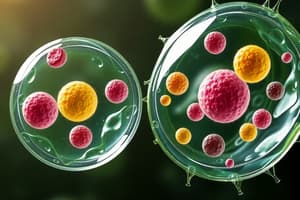Podcast
Questions and Answers
What distinguishes prokaryotic cells from eukaryotic cells?
What distinguishes prokaryotic cells from eukaryotic cells?
Prokaryotic cells lack a nucleus and membrane-bound organelles, while eukaryotic cells have them.
The mitochondria are known as the ______ of the cell.
The mitochondria are known as the ______ of the cell.
powerhouse
What is the main function of the mitochondria?
What is the main function of the mitochondria?
To produce adenosine triphosphate (ATP) through cellular respiration.
Which of the following structures is responsible for regulating the environment within the nucleus?
Which of the following structures is responsible for regulating the environment within the nucleus?
What role does cytochrome C play in the mitochondria?
What role does cytochrome C play in the mitochondria?
The Golgi apparatus is responsible for protein synthesis.
The Golgi apparatus is responsible for protein synthesis.
What structures make up ribosomes?
What structures make up ribosomes?
The rough endoplasmic reticulum is primarily involved in ______ and export proteins.
The rough endoplasmic reticulum is primarily involved in ______ and export proteins.
What is the main role of the nucleus in a cell?
What is the main role of the nucleus in a cell?
Flashcards are hidden until you start studying
Study Notes
Prokaryotic and Eukaryotic Cells
- Prokaryotic cells are simpler, lack a nucleus, and have no membrane-bound organelles. Examples include bacteria and archaea.
- Eukaryotic cells are complex, contain a nucleus, and possess membrane-bound organelles. Examples include plant and animal cells.
- Technologies such as microscopy and cell staining help determine cell structure and function.
Cell Membrane and Structure
- The fluid mosaic model describes the cell membrane as a dynamic structure composed of phospholipids, proteins, and carbohydrates, allowing for flexibility and movement.
- Cell organelles perform specific functions critical for cellular processes, with arrangements varying based on cell type.
Cellular Coordination and Environment Interaction
- Diffusion is the passive movement of molecules from high to low concentration.
- Osmosis refers to the diffusion of water across a semipermeable membrane.
- Active transport requires energy to move substances against their concentration gradient.
- Endocytosis is the process where cells engulf materials from the external environment.
- Surface area to volume ratio affects the efficiency of transport processes in cells.
- Concentration gradients drive the movement of substances in and out of cells.
Energy and Waste Management
- Cells require various forms of energy to perform functions, including ATP generated through cellular respiration and photosynthesis.
- Removal of waste products is essential for maintaining cellular homeostasis, particularly in eukaryotic cells.
- Enzymes facilitate biochemical reactions, and their activity can be influenced by environmental factors like temperature and pH.
Organelles: Structure and Function
-
Mitochondria:
- Act as the powerhouse, producing ATP through cellular respiration.
- Double membrane with an intermembrane space, enhancing surface area for ATP synthesis.
- Contains cytochrome C for the electron transport chain and has its own DNA.
-
Nucleus:
- Control center of the cell storing genetic information.
- Comprises a nuclear envelope with pores, nucleoplasm, and nucleolus for ribosome synthesis.
-
Golgi Complex:
- Responsible for protein transportation and waste export.
- Made of 6-8 stacked cisternae, increasing surface area for efficient transport.
-
Ribosomes:
- Sites for translating mRNA into amino acid chains for protein synthesis.
- Comprise two subunits that facilitate the binding of mRNA and tRNA.
-
Rough Endoplasmic Reticulum:
- Assists in the synthesis and export of proteins, highlighted by its ribosome-studded surface.
Studying That Suits You
Use AI to generate personalized quizzes and flashcards to suit your learning preferences.



